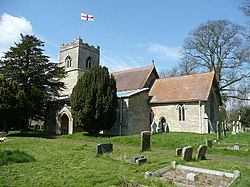Little Horwood
| Little Horwood | |
| Buckinghamshire | |
|---|---|
 St Nicholas' parish church | |
| Location | |
| Grid reference: | SP791306 |
| Location: | 51°58’8"N, -0°50’58"W |
| Data | |
| Population: | 434 (2011) |
| Post town: | Milton Keynes |
| Postcode: | MK17 |
| Dialling code: | 01296 |
| Local Government | |
| Council: | Buckinghamshire |
| Parliamentary constituency: |
Buckingham |
Little Horwood is a village in northern Buckinghamshire, about four miles east of Buckingham and two miles north-east of Winslow.
The village, like its neighbour Great Horwood, is named from the Old English for "dirty or muddy wood". The Anglo-Saxon Chronicle of 792 records the villages as Horwudu.
Parish church
The parish church is the Church of St Nicholas. It has a Perpendicular Gothic belltower built of large blocks of ashlar, while the remainder of the church externally dates from the restoration of 1889 by the architect James Piers St Aubyn. In contrast with St Aubyn's other, ruthless restorations, at Little Horwood the interior survived relatively unscathed and the early 16th century wall paintings depicting the seven deadly sins, part of pre-Reformation theology, survived as did the Jacobean pulpit and the Decorated Gothic chancel arch.
The tower has a ring of five bells with a tenor of 9cwt 2qtrs 22lbs, tuned to the note of G.
The manor
The manor of Little Horwood anciently belonged to the abbot and convent of St Albans. It was seized by the Crown in the Dissolution of the Monasteries in the mid 16th century. It was later sold to George Villiers, 1st Duke of Buckingham who remodelled the manor house, which is now demolished.
One mile south east of the village is Horwood House.
Confusingly, there is also a house named 'Little Horwood Manor' (itself Grade II listed), which is not the manor house for Little Horwood but is a comparatively modern house, designed by A.S.G. Butler in 1938 for the industrialist George Gee.[1]
Located between the village and near-by Great Horwood is RAF Little Horwood, a Second World War airfield was constructed in 1940,[2] and was operational from 1942 to 1946.
See also
Outside links
| ("Wikimedia Commons" has material about Little Horwood) |
References
- ↑ Stables at Little Horwood Manor - British Listed Buildings
- ↑ RAF Little Horwood - Open University